Huntercombe Golf Club
Henley-on-Thames, ENGLAND

Hollows and wild greens define Willie Park Junior’s land mark design at Huntercombe. Note the nearly four foot drop (!) in the middle of the 4th green.
At the turn of the twentieth century only coastal courses incorporated features that were both natural in appearance and attractive to the golfer. Though great strides had been made at places like Royal Worlington & Newmarket and Woking, man generally struggled to make inland golf anywhere near as engaging to play as links golf. His attempt at moving dirt was frequently heavy-handed, unnatural in appearance and failed to produce the strategic conundrums found on the great links.
Willie Park Junior changed much of that in 1901 when he opened three courses that established new design standards for inland golf. Those courses were Sunningdale, Notts and Huntercombe. Of the three, Park invested his own money in only Huntercombe, where he became the Managing Director of what he had hoped would become a successful real estate venture (alas, it didn’t). A descendant of one of golf’s most noted families, his father Willie Park Senior won the first Open Championship and three others. His uncle, Mungo, also became Open champion and the brothers made a further name for themselves by founding a well known golf club and ball company based in Musselburgh, Scotland. Park Junior himself won the Open in 1887 and 1889 while helping to run the family business. From this pedigree background, Park developed strong ideas as to what constituted good golf.
In 1900, a confident Park personally purchased Huntercombe Manor and over 900 acres and availed himself of another 113 acres of common ground. Alone, he drove the design of Huntercombe, free from committees or other outside influences. Huntercombe was a highly personalized design for Park and he poured everything into the course that he thought made the game enjoyable. Park needed to because motor cars had yet to grab hold in England and going for a game in the Chilterns forty miles west of London in Oxfordshire was far more time consuming than now.
Here is the description of Huntercombe from an early advertisement: “Situated on the Chiltern Hills, 700 feet above sea-level, playable all the year round, a perfect seaside course – inland, grand old turf, gravel and sand subsoil, health giving breezes, an ideal course for London golfers.” The best part? The virtues and playing characteristics promised hold nearly as true today as they did in 1901.
Two design features stand out at Huntercombe. One is the imaginative green contours and the other is the absence of artificial, man-made hazards (a.k.a. bunkers).
First, the greens and their surrounds: Bear in mind that the man who designed this course is the same one who later penned The Art of Putting. Highlighted by a four foot change in elevation in the fourth green and the famous three foot step-up at the much photographed eighth green, Huntercombe featured interior contours the likes of which had yet to be built on an inland course anywhere in the world. To put this in perspective, Charles Blair Macdonald, Walter Travis, Alister MacKenzie, A.W. Tillinghast, Perry Maxwell and others were still years away from building greens that would make each famous. Park and Huntercombe came first in a landmark moment in golf course architecture. Indeed, Harry S. Colt, the standard bearer of U.K. architects, never built a series of putting surfaces as bold as the ones at Huntercombe.
Greens such as the first, second, third, fourth, eighth, twelfth, thirteenth, and fifteenth need to be seen to be believed. To this day, they imbue the course with sparkle that few others possess. Clearly, Park, a Scot, was heavily influenced by the greens he saw at North Berwick, Prestwick and The Old Course at St. Andrews and he brought that knowledge south to Oxfordshire.

The 8th green sweeps up three feet from fairway level to a back plateau that is a scant fourteen paces deep. Stopping an aerial approach shot on it is unlikely for most club golfers so they have to fashion some sort of a running approach shot.
The other most remarkable design feature is Park’s use of hollows and depressions instead of bunkers. The course opened with less than twenty-five bunkers and today has only thirteen. People consider MacKenzie’s design of Augusta National to be revolutionary in this regard but Huntercombe pre-dates it by thirty-one years! Park employed centerline depressions and hollows that dictate the line of play with holes three, four, five, six, nine, thirteen, fourteen, fifteen, sixteen and seventeen all prime examples.
Huntercombe’s design brought immediate praise, none more succinct or flattering than that by Walter Travis who called it ‘easily the best laid out links that I have ever played over anywhere.’ Similar to Woking Golf Club, Huntercombe attracted some of the finest minds in golf course architecture to its membership including C.K. Hutchison, J. F. Abercromby, Charles Hugh Alison, and Stuart Paton. A powerful figure in golf, Park held sway with his peers and his innovative use of the land and his imaginative greens at Huntercombe set the stage for an impressive boon in golf course development around greater London. In fact, many consider 1901 as the start of the Golden Age of golf course architecture.
Later in 1951, Henry Longhurst joined the club and more than anyone championed the joys of a game at Huntercombe. As we see below, the venue still lives up to the lofty praise.
Holes to Note
First hole, 145 yards; Considering that Huntercombe represents Park’s design ideal, the first time visitor is surprised to be greeted on the first tee with the shortest hole on the course. Surely, the sequence of holes must have changed at some point? Indeed, it has. Upon Lord Nuffield’s death, today’s clubhouse was built in 1963 some thousand yards from the original one and the sixth hole became today’s first after a narrow club vote. Nonetheless, the bunkerless first gives a taste of what’s to come with its inspiringly contoured green that slopes away from the tee.
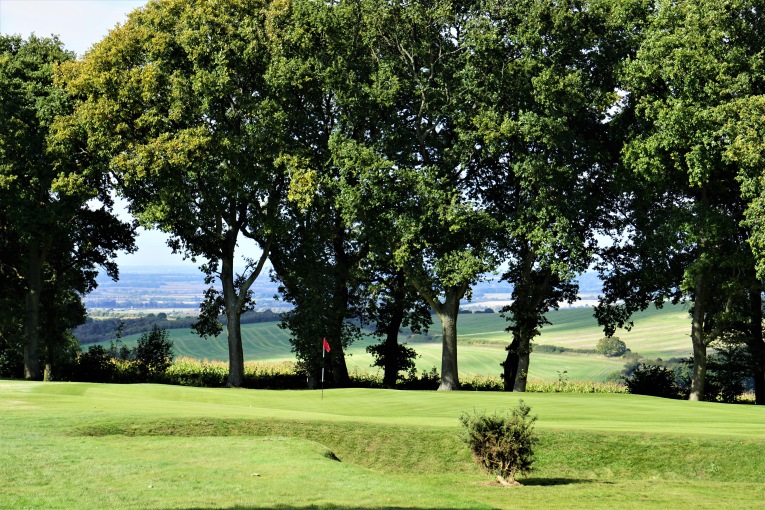
Recent clearing of brush from underneath the trees has improved air flow and enlivened the backdrop at the 1st. With firmer turf conditions, getting one’s tee ball close to forward hole locations is especially problematic.
Second hole, 420 yards; The most dramatic long view afforded at Huntercombe comes early in the round. Bunkerless, the second still gives the golfer all that he can handle. Both its fairway and green play off the same broad right to left slope and Park’s exploitation of the land is nothing short of superlative. Judging where and how to land one’s approach shot is as vexing today as it was in Park’s era and certainly brings into sharp focus how deadly dull courses are that reward only aerial play.
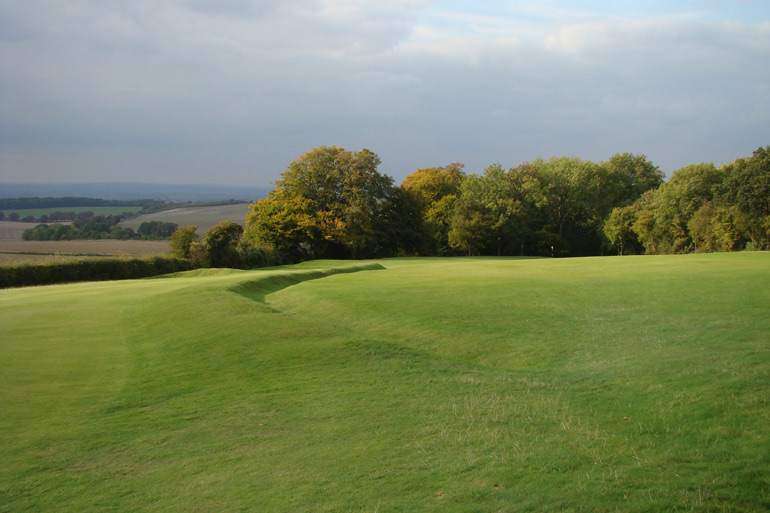
The endlessly fascinating approach: Do you land it twenty yards high and right of the green and let it trundle down onto the putting surface or fly the ball onto the green and thus take away some of the slope?
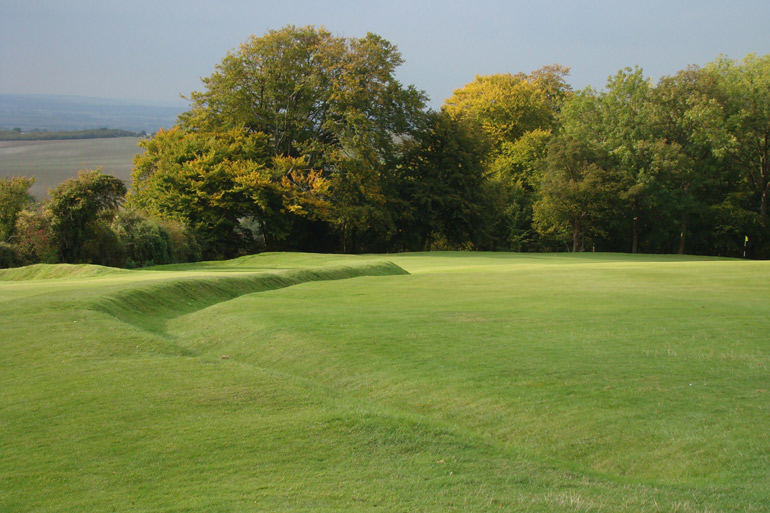
Though the 2nd lays peacefully upon the ground, Park undertook quite a bite of earth work to prop up the left side of the green complex. This represents one of the earliest examples in inland golf of being unable to distinguish where nature stops and man’s hand begins. As such, Huntercombe marks a seminal moment in golf course architecture.
Third hole, 365 yards; A formidable depression left of the driving zone ensures that the golfer doesn’t cheat much. At 4,300 square feet, the third green enjoys only ~1,200 square feet of cupable area within its fierce right to left slope. Similar to the second, the qualities of its approach haven’t diminished one iota with time. Round after round, the golfer relishes the opportunity to challenge the design by figuring out how to get the ball close. Truth be told, the surest way is to eschew the direct, modern aerial assault and to hit a low runner as much as seven paces right of the green’s edge. Watching the drama slowly unfold along the ground as a low running ball takes the slope and trickles toward the one portion of the putting surface that will hold is a thing of lasting joy. The club’s diligent work in firming up the ground in recent times is in evidence here as it allows the ground game shot to be played to perfection. Pitifully few inland courses offer such satisfying moments of judging how to have a ball interact with the ground for 20 or 30 yards; a round at Huntercombe stands out.
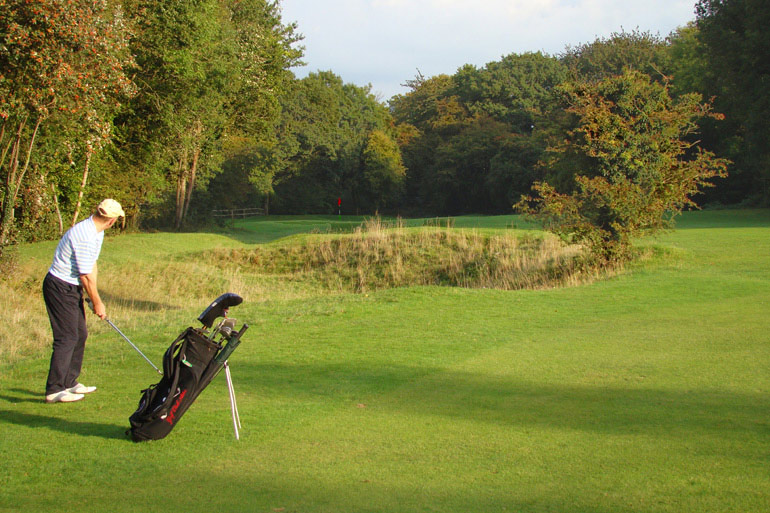
Time will show that the best approach might land as far as 25 yards to the right of the red flag.
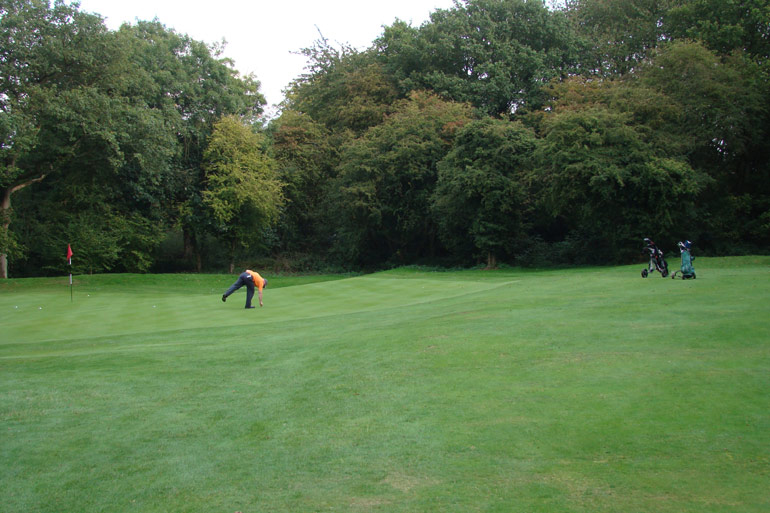
There is six feet of drop from right of the green to the left edge of the putting surface so hitting a low approach on line with the trolleys and letting gravity do the rest is a fine way to tackle the conundrum.
Fourth hole, 330 yards; Little has changed with the fourth hole in its first 115 years. As such, it is highly instructive in appreciating just what a bold design Huntercombe was at inception. Like many holes at St. Andrews, its character drastically changes based on the day’s hole location. When located on the top left tier, the player may drive the green downwind and have a manageable eagle putt. Move the hole to the bottom right tier and the complexion changes. At the time, 1901, the only greens with such wild interior contours were those found along the coast at such famous links as North Berwick, St. Andrews, and Prestwick. Golf course architects had yet to bestow inland greens with much character save for tilt. Park revolutionized all that with a series of arresting green complexes at Huntercombe with the one at the fourth being a particular marvel.
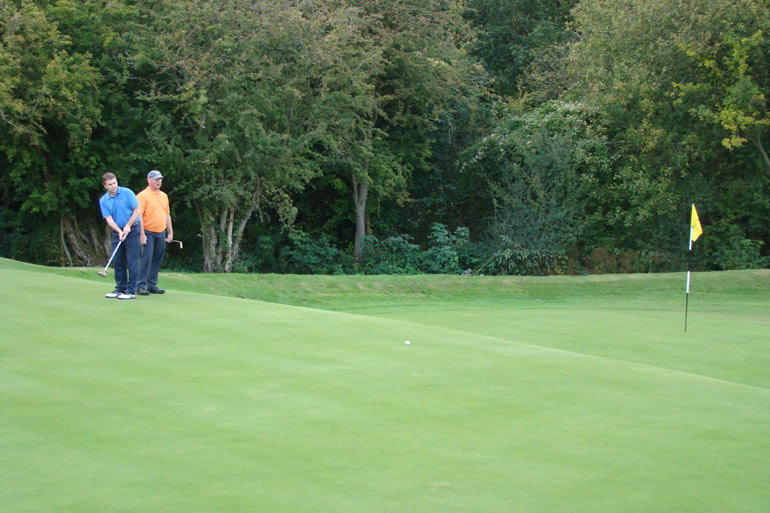
Disaster! This poor soul’s ball stayed on the top tier and he is trying any means possible (including putting with his back to the hole) to get this ball within 10 feet of the hole with his first putt.
Sixth hole, 520 yards; The club has been a worthy steward of Park’s design. Even here, where things had to change for safety, the hole still reflects Park’s overall design theme. Originally, Park had this fairway and green hug the road, which was much less trafficked. By the early 1970s, the club had no choice but to steer play away from the busy road. Today, Park’s depressions and the new green built in 1971 work well in concert. The green’s left to right tilt still rewards the golfer that favors playing down the side with the most trouble (i.e the right).
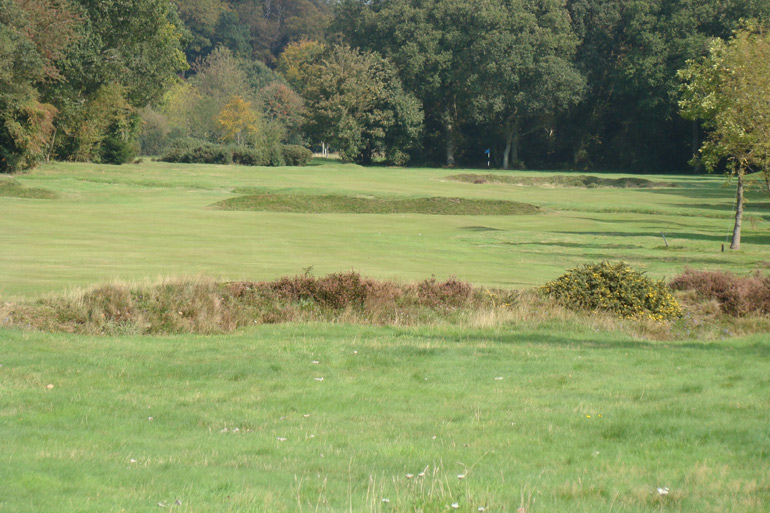
The need to hit the fairway …

… and avoid the shallow heath filled depression ninety yards short of the green are the key underpinnings to playing the 6th well. Appearing as nothing more than an extension of the fairway, the fine green is of the sort that sadly is rarely built today.
Seventh hole, 215 yards; Park looked for ways to improve the course until his death in 1925. Approximately a dozen years after Huntercombe opened, he created the mounds that are now the seventh’s prominent feature. Variety was keenly important to Park and nowhere is that better demonstrated than by comparing this green complex with the next.
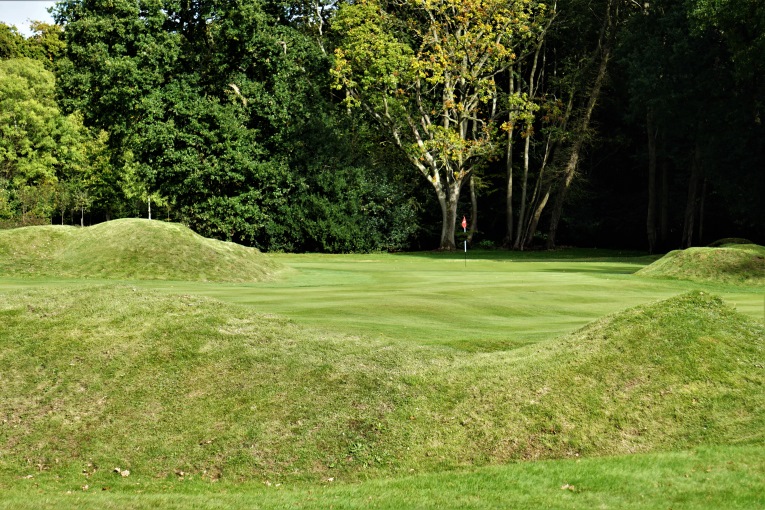
Laid over flat terrain, Park eventually decided to build a series of mounds left and right of the green as a means of giving the hole both visually interest as well as enhanced playing qualities.
Henley-on-Thames, ENGLAND
Eighth hole, 425 yards; The pleasure of a well hit drive is compounded by affording the golfer the joy of one of the most fun approach shots imaginable. In direct contrast to the last hole, Park moved dirt at the eighth only to create a dramatically tiered putting surface. This much loved green complex has been written about and photographed for 115 years – and deservedly so. By making the top tier so narrow, Park again forces the golfer to consider using the ground as his chief ally. On the rare occasion that the hole is placed on the larger, lower portion, birdies become a distinct possibility as the green’s bank helps brake approach shots, curling the ball back toward the hole.
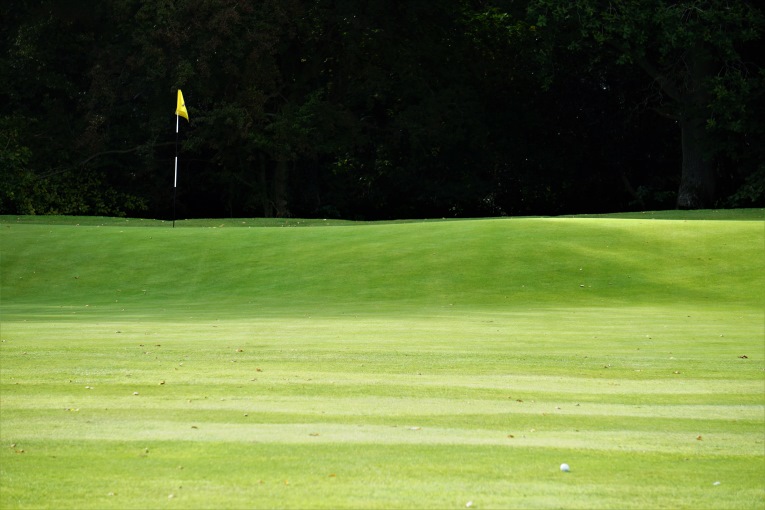
The odds of getting down in two aren’t in the golfer’s favor especially as the putting surface slopes away on the top level. Like St. Andrews, merely finding the green isn’t enough. A poorly positioned approach makes a bogey just a matter of time.
Tenth hole, 180 yards; A single fronting bunker and a green that slopes away give the hole its enduring golf qualities. Again like at St. Andrews, missing the green short often creates the most problematic recovery; the golfer is better served by positioning his tee ball beyond the day’s hole location. Even master golf course architects like A.W. Tillinghast and Donald Ross fell into the trap of making too many of their greens slope from back to front, taking mystery out of where the best miss might be. Not so with Park who forces the golfer to be vigilant and confront a variety of situations, taking nothing for granted. In this manner, this inland design pays homage to the great Scottish links.
Twelfth hole, 435 yards; The course in America that best embodies the design tenets as espoused by Park at Huntercombe is Garden City Golf Club on Long Island, which features central hazards and canted greens at grade. While Garden City is much more profusely bunkered, both courses share the same wonderful, streamlined visuals from tee to green with many features muted rather than pumped up. Frequently presented as extensions of the fairways, the putting surfaces at both courses are more elusive as targets because they aren’t so cleanly defined and obviously presented. Architects too often rely on built-up green pads and while they often do so for drainage, eighteen pushed-up green pads run the risk of creating a repetitive ask of the player. Park found property well suited for golf that was blessed with sandy soil ideal for drainage. He took advantage by creating greens like this one that is at grade with its surrounds. More astute judgement is required from the player standing in the fairway. In the case of the twelfth, a three foot drop in elevation from the green’s left to the green’s right side keeps the golfer on his toes.
Thirteenth hole, 400 yards; The favorite hole of some members, this hole feels like the Home hole it was once. Originally, the clubhouse sat behind the green and the first hole (today’s fourteenth) started on the other side of the road. The hole’s chief playing characteristics is broken ground in the center of the fairway and one of the finest greens on a course full of exemplary putting surfaces.
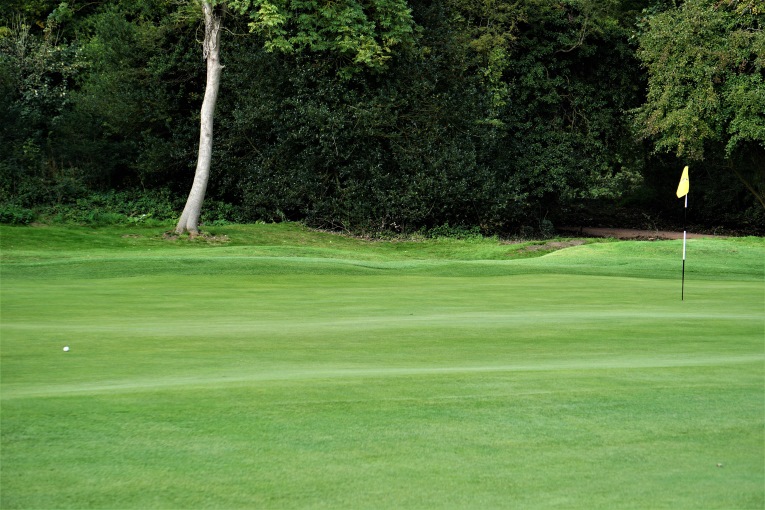
Angled from front left to back right, the 13th green is one of the deepest on the course and features random ridges throughout.
Fourteenth hole, 425 yards; The third tough par four in a row, the golfer realizes that Huntercombe isn’t a museum piece but rather a comprehensive test. Juxtaposed against today’s over-built, over-shaped courses, one gains a renewed appreciation for what Park accomplished at Huntercombe. He got more out of less while today’s architects rountinely get little out of more!

This hollow left off the tee and another right of the green lend enduring strategic merit to the 14th.
Fifteenth hole, 185 yards; The early rounds at Huntercombe were played with the gutty ball and hickory shafts. What a challenge it must have been as Huntercombe holds the distinction of being one of a few Golden Age courses that was actually longer when it opened than it is today. In 1901, Huntercombe measured over 6,500 yards compared to 6,319 yards today. Perhaps Park was made aware of the imminent arrival of the Haskell ball when he traveled to North America before the turn of the twentieth century? As a ball and club maker, Park certainly enjoyed insight into the direction of technology. This might explain Huntercombe’s healthy length, some of which came from a stout set of one shot holes. The fifteenth, for instance, measures the identical distance today as it did on opening day. Even with a Haskell ball, it calls for some sort of a long iron played over two deep pits to a bowl contoured green. With the gutty, a wood was required, save for someone the caliber of Park. Interestingly enough, Bernard Darwin once commented that he found Park’s Sunningdale to be more interesting in the days after the Haskell was introduced as it allowed for a greater variety of approach shots. When played with the gutty, Darwin felt fairway wood approach shots were required perhaps too frequently at Sunningdale.
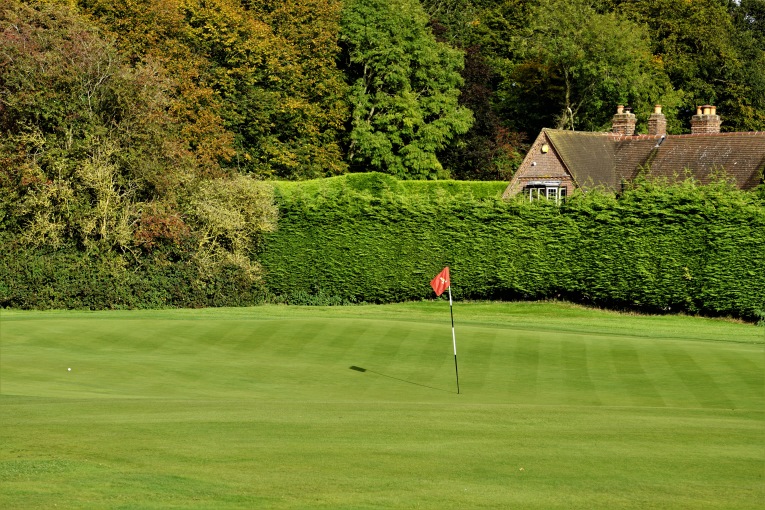
As it is, they are well back from another marvel of a putting surface and where the ground short of the green becomes supremely important in how best to play the hole.
Sixteenth hole, 470 yards; One benefit of the current sequence of holes is that Huntercombe enjoys an exciting three hole finish. Yes, it has the prototypical tough eighteenth but the prior holes are both 1/2 pars where anything can – and frequently does – happen.
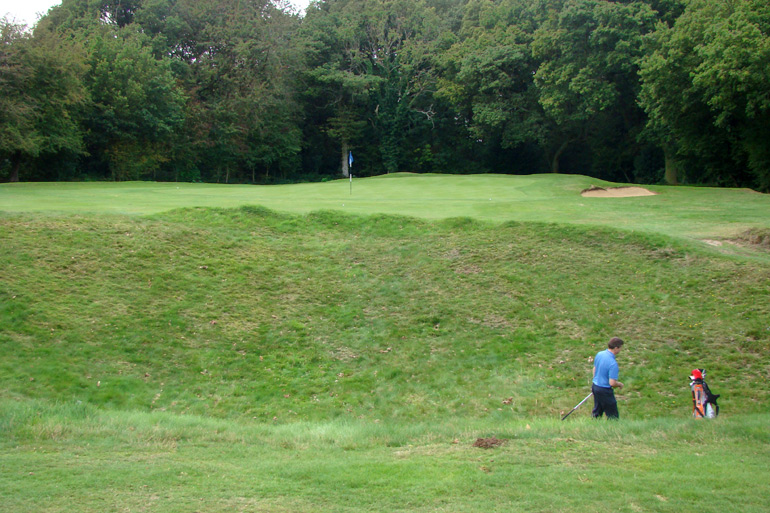
At thirteen feet, this is the deepest hollow on the course and it is perfectly positioned to discourage those contemplating reaching the green in two.
Seventeenth hole, 270 yards; Will the golfer be clear-headed when he plays the penultimate hole or will greed do him in? A five wood or a utility club is all that is needed off the tee but the golfer very much needs to find the fairway. From there, the matter becomes pitching to the proper level of a tiny 3,300 square foot green for a birdie chance. A total finesse hole, it is memorable for being the sort of hole that regrettably is not often found late in a round. Too many short two shotters have proliferated in recent times that rely on water and thus throw off a proper balance between risk and reward. Here, apart from being in a grouse bush, all the trouble is recoverable from and thus, the golfer is goaded into often unwise, aggressive tactics.

All manner of trouble is left and once out of position, the tiny, push-up green becomes problematic to hit.
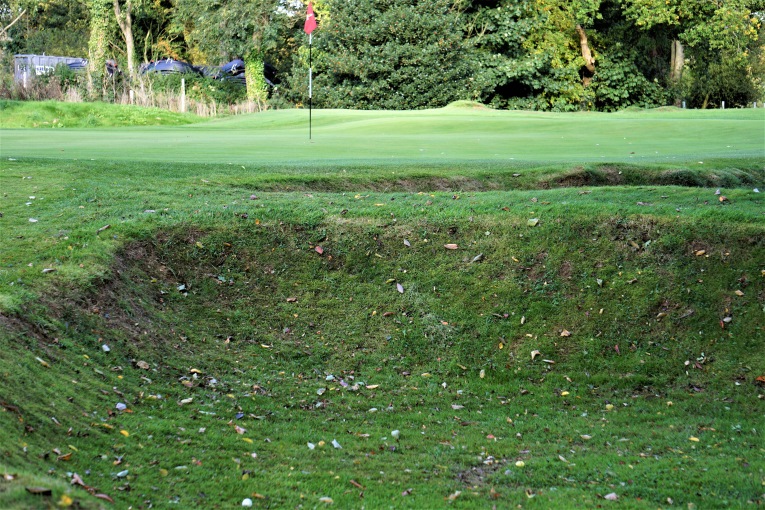
… finds its way to this greenside depression. The ball then decided to find the next depression and after three more blows, a bogey was registered after having been nearly hole high in one. The author was forced to shake hands in a bitter 2 down defeat, having learnt a valuable lesson about trying to force things at this gem of a hole.
Though all seems quite well at Huntercombe, one playing aspect has changed for the worse over the first century, namely tree and brush growth. The editor of Golf Illustrated crowed early in Huntercombe’s history of the ‘endless distance’ and how a game there reminded him of the Lothians. Sadly, that is no longer true. Vegetation now blocks the vistas, save for the one enjoyed along the second hole. Happily, since the author’s first visit in 2011, the club has turned its attention toward this matter. Progress can be seen at the aforementioned first hole where the removal of brush and the limbing up of branches have exposed views and allowed wind and filtered light to reach the green. This is a most encouraging step though much remains to be done as the golf is too often confined to corridors of dense woods. Just imagine what an unobstructed back drop would mean for an approach shot to a green like the fourth. In the club’s defense, some of the land is common ground and they don’t have the ability to remove plants that obstruct what would otherwise be superb long views. More is the pity because another unintended consequence of the vegetation is the muffling of the wind, a crucial attribute to great golf.
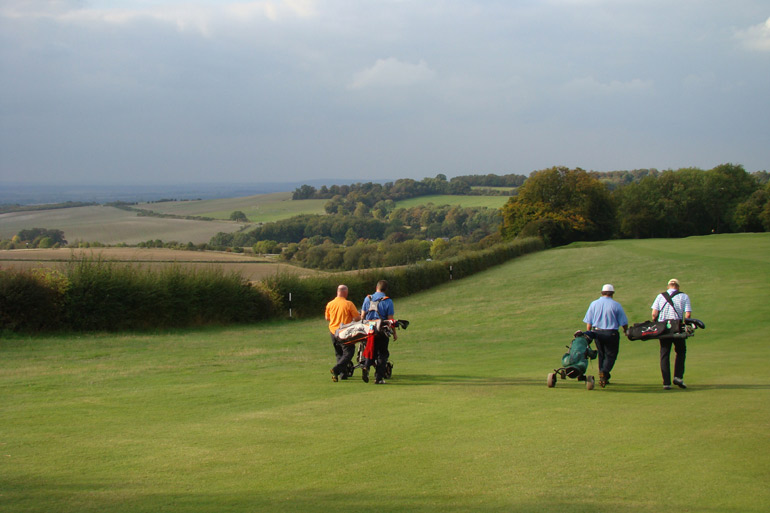
The bracing air these gentlemen feel as they trundle down the 2nd fairway could – and should – be more prevalent throughout the course.
Save for that growth, the vast amount of Park’s work here remains wholly intact. Thus, to appreciate Park as a designer, there is no better course to see and study. That is reason enough to celebrate and a game here remains unlike most you can play anywhere. Imaginative greens and centerline hazards are just as effective in this century as the last. The absence of eye-candy bunkering – and the never ending maintenance costs tied to such hazards – is surely something that many modern architects should appreciate. Designs like Huntercombe that stand up so well through time are a rarity worth exploring.
In The Best of Henry Longhurst compiled by Mark Wilson, Longhurst talks about the indestructible qualities of certain courses. In particular, he was referring to the Old Course at St. Andrews. Yet, his comments pertain equally well to Huntercombe. Longhurst said it best when he wrote, ‘alterations to Huntercombe should only be made over my dead body.’
The End



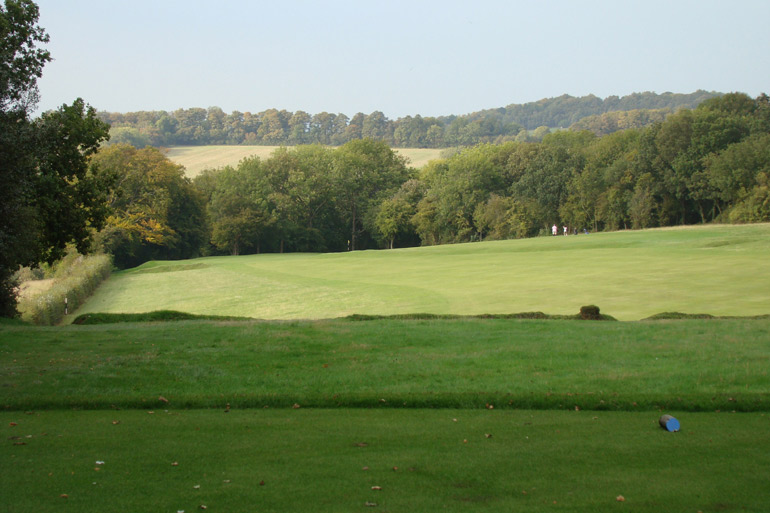
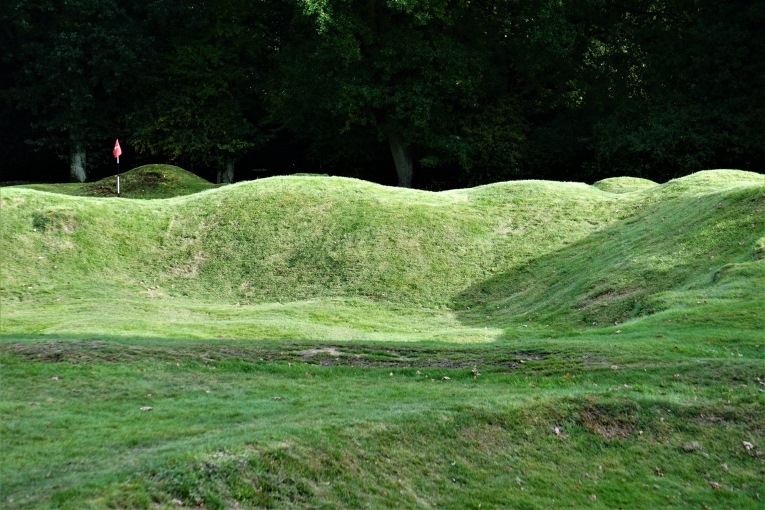

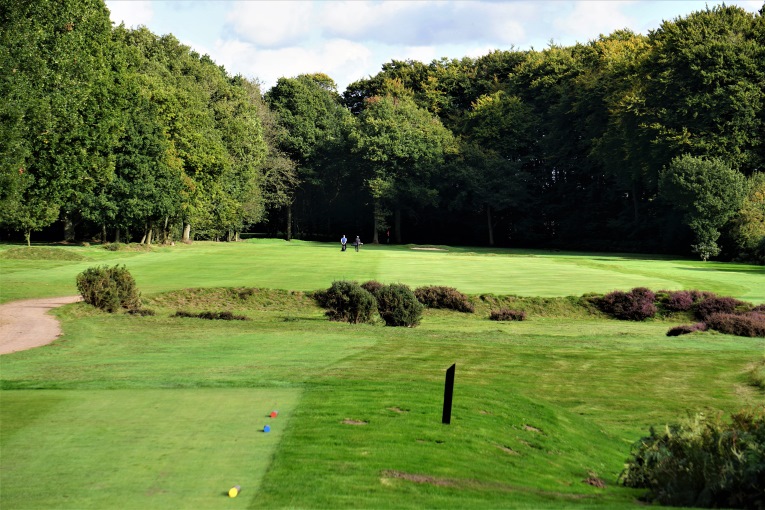





![Minchinhampton (Old) [2016]](https://golfclubatlas.com/wp-content/uploads/2018/09/Minchinhampton-500x383.jpg)
![St. Enodoc (Church) [2017]](https://golfclubatlas.com/wp-content/uploads/2017/11/St.-Enodoc-500x383.jpg)
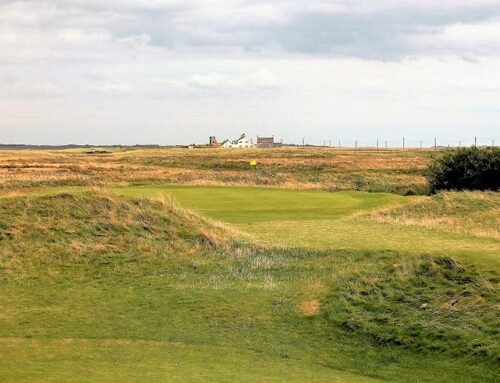
![Sunningdale (Old) [2014]](https://golfclubatlas.com/wp-content/uploads/2017/11/Sunningdale-Old-Course-500x383.jpg)
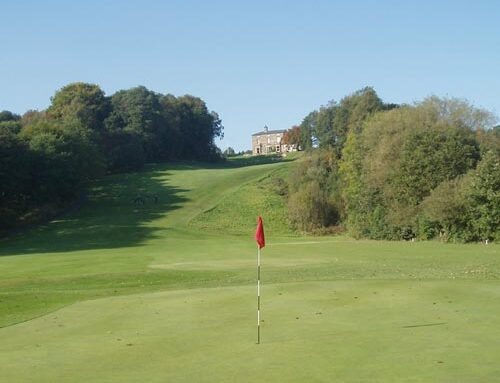
![Sunningdale (New) [2009]](https://golfclubatlas.com/wp-content/uploads/2010/12/Sunningdale-New-Course-500x383.jpg)